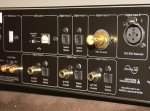But why would this be used? In what context?
Maybe give some scenarios where it would be found?
Why would a student need to know this etc?
There are various practical uses for s/pdif & ADAT to send & receive digital audio. And as said, there are different types of digital audio connections, the connection type itself, ie; what kind of physical connector used, and the protocol, ie; the electrical properties of a given type, how many channels it's cable of transmitting & receiving, etc.
That said, the s/pdif
'protocol' (2 channel/stereo digital audio) can be carried over coaxial cable with RCA connectors, BNC or other connectors which are typically 75 Ohm, or s/pdif can be carried over optical cable with Toslink connections.
ADAT can also be carried over the same optical cables & Toslink connectors as s/pdif, but the 'protocol' is different than s/pdif, because ADAT carries up to 8 channels of digital audio. This means you can have 8 mono channels, or 4 stereo channel pairs depending on how you assign them, pan etc.
Note;There's also ADAT SYNC (synchronization) cable connections using 9 pin D-sub connections, though they commonly transmit 'sync' and midi. I believe for digital audio, the D-subs transmit the AES protocol as far as I know. Using Toslink over optical is the standard for ADAT digital audio though.
Furthermore & typically, as I understand it, s/pdif over BNC is often associated with a more professional standard (+10 dB), while RCA's are typically associated with a consumer standard (-10dB).
You should research and verify what anyone say's on forums though, including from me.
The reason a student would need to know this, is to be able to understand how use it properly for a given scenario. To have a basic understanding (only what I have) just to be able to use it (what I do) is all that's needed. You don't have to be an expert (which I am not).
In my own practical use; I use mostly s/pdif over 75 Ohm coaxial cable with RCA connections. I use cables made specifically for digital audio (rather than standard audio cables). I buy HOSA brand myself, they're not expensive, but they're good.
What I use s/pdif for, is to send/receive stereo digital audio signals among music DAW (Cubase) computers, via their own audio interfaces (higher end external sound cards) installed.
I also use ADAT over optical cable/Toslink connections when I need to send 8 channels of digital audio among my DAW computer systems.
S/pdif & ADAT is used to send/receive digital audio among many other types of devices, not just DAW's of course....consumer & pro devices.
Another common use for ADAT is when using 2 audio interfaces in the same computer, one ran into the other via their ADAT, typically to to add more I/O's.
If sending digital signals via s/pdif or ADAT devices outputs, directly to receiving devices via their s/pdif or ADAT inputs, you don't typically need anything in between those devices except cables.
If you're using an s/pdif or ADAT input for non s/pdif or ADAT devices, you'll need (what was said by someone in this thread) a Mic pre with s/pdif or ADAT out. I myself do not require anything but digital cables in my own scenario, as I send & receive only pure digital audio with s/pdif or ADAT among my audio interfaces My interfaces take care of any digital to analog/analog to digital conversions as needed, to my monitoring equipment etc.
Digital audio is not only cable of carrying 'digital audio' but also can carry clock information, synchronization, midi information and transport information. In fact with my own use, I do just that with my DAW PC's, running Stenberg Cubase's own proprietary VST System Link, which works via any type of digital audio connections among any number of computers. This allows one to run several computers in perfect synchronization, linking the transports together.



